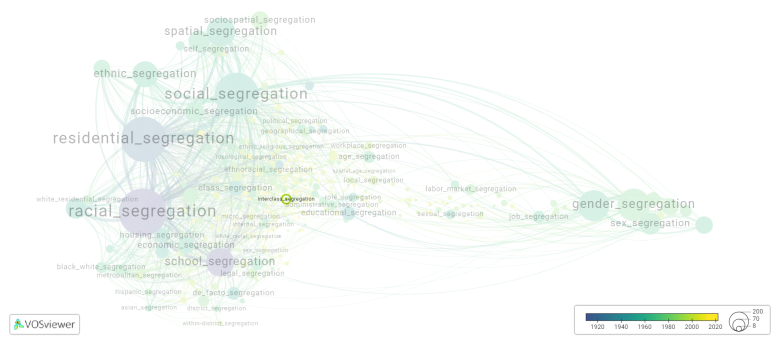Interclass segregation: Difference between revisions
(Creating page) |
(Creating page) |
||
| Line 18: | Line 18: | ||
Efforts to reduce interclass segregation involve promoting equal opportunities, access to quality education and healthcare, and affordable housing. Addressing this issue requires implementing policies and initiatives that aim to bridge the gap between social classes and promote social cohesion. | Efforts to reduce interclass segregation involve promoting equal opportunities, access to quality education and healthcare, and affordable housing. Addressing this issue requires implementing policies and initiatives that aim to bridge the gap between social classes and promote social cohesion. | ||
==See also== | ==See also== | ||
==Related segregation forms== | |||
Interclass segregation is frequently discussed in the literature with the following segregation forms: | |||
[[racial segregation]] | |||
[[File:interclass_segregation.png|780x780px]] | |||
For the complete network of associated segregation forms, see: | |||
year of publication https://tinyurl.com/2235lkhw | |||
Louvain clusters https://tinyurl.com/2d8wg5n3 | |||
betweenness centrality https://tinyurl.com/223udk5r | |||
disciplines where segregation forms first appeared https://tinyurl.com/244d8unz | |||
==References== | ==References== | ||
==Notes== | ==Notes== | ||
Revision as of 14:36, 27 September 2024
Date and country of first publication[1]
2006
United States
Definition
Interclass segregation refers to the separation of individuals from different social classes within a society. This separation can occur in various contexts, such as residential areas, educational institutions, workplaces, and social activities.
In terms of residential areas, interclass segregation commonly manifests as the division of neighborhoods into distinct sections based on socioeconomic status. Higher-income individuals often live in affluent areas with better amenities and services, while lower-income individuals are confined to less desirable neighborhoods with limited resources.
Interclass segregation can also be observed in educational institutions. Private schools, which typically cater to wealthier families, often provide superior educational opportunities compared to public schools, which generally serve lower-income communities. This discrepancy can perpetuate socioeconomic inequality by limiting access to quality education for certain individuals.
Workplaces also tend to exhibit interclass segregation. Higher-paying jobs with more opportunities for career advancement are often concentrated in specific industries or organizations that require higher levels of education and expertise. Consequently, individuals from lower socioeconomic backgrounds may face barriers to entering these industries or organizations, limiting their upward mobility.
In social activities, interclass segregation can be seen in the separation of individuals based on their ability to afford certain leisure activities. Wealthier individuals have access to exclusive clubs, fine dining establishments, and luxurious vacations, further isolating them from those with lower incomes.
Interclass segregation has detrimental effects on society, as it reinforces social and economic inequalities. It can perpetuate a cycle of poverty and limit social mobility, making it difficult for individuals from lower socioeconomic backgrounds to improve their circumstances. It can also contribute to the creation of social divisions, hamper social integration, and reinforce stereotypes about different social classes.
Efforts to reduce interclass segregation involve promoting equal opportunities, access to quality education and healthcare, and affordable housing. Addressing this issue requires implementing policies and initiatives that aim to bridge the gap between social classes and promote social cohesion.
See also
Related segregation forms
Interclass segregation is frequently discussed in the literature with the following segregation forms:
For the complete network of associated segregation forms, see:
year of publication https://tinyurl.com/2235lkhw
Louvain clusters https://tinyurl.com/2d8wg5n3
betweenness centrality https://tinyurl.com/223udk5r
disciplines where segregation forms first appeared https://tinyurl.com/244d8unz
References
Notes
- ↑ Date and country of first publication as informed by the Scopus database (December 2023).
At its current state, this definition has been generated by a Large Language Model (LLM) so far without review by an independent researcher or a member of the curating team of segregation experts that keep the Segregation Wiki online. While we strive for accuracy, we cannot guarantee its reliability, completeness and timeliness. Please use this content with caution and verify information as needed. Also, feel free to improve on the definition as you see fit, including the use of references and other informational resources. We value your input in enhancing the quality and accuracy of the definitions of segregation forms collectively offered in the Segregation Wiki ©.
Interclass segregation appears in the following literature
Strait J.B. (2006). Poverty concentration in the prismatic metropolis: The impact of compositional and redistributive forces within Los Angeles, California, 1990 2000. Journal of Urban Affairs, 28(1), 71-94. https://doi.org/10.1111/j.0735-2166.2006.00260.x

